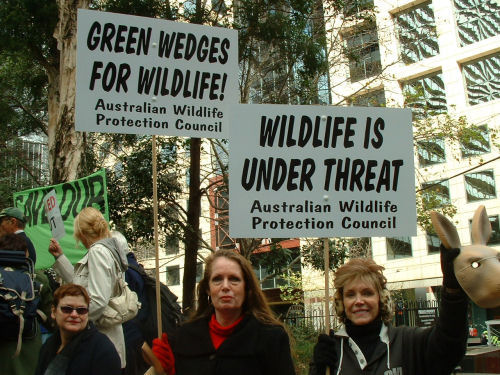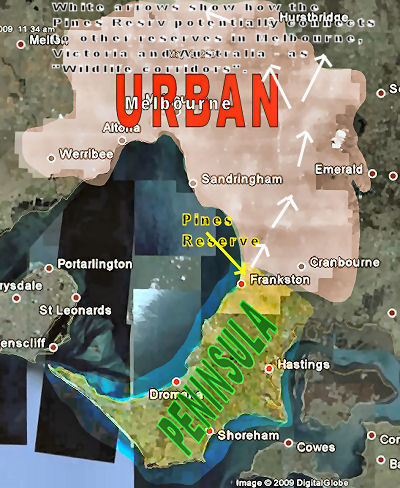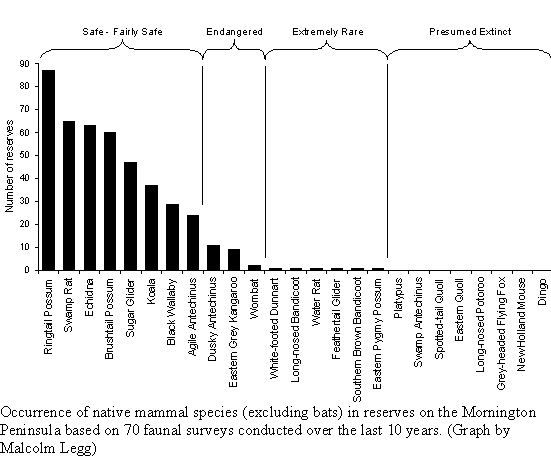by Sheila Newman and Richard Laverack
Why build more roads now?
Why on earth, with petroleum supplies not meeting demand and oil prices through the roof, are we still engaging in public-private partnerships with road builders???

Australia is currently set to be criss-crossed by new roads, tunnels and tollways. A case in point, which we have studied is the SEITA Eastlink tollway, which is being built by ConnectEast in a private-public partnership with the Victorian Government.
So, why is Victoria engaged in massive road construction just now? And, why are we persisting with Eastlink, all the way down the Mornington Peninsular when we could simply stop it now?
We found some strange answers to our question towards the end of a SEITA document called, "Frankston Bypass Environment Effects Statement, Strategic Transport Modelling Technical, dated 3rd March 2008, in "Clause 5.7 - Impacts of Fuel Price Changes."
"The MITM adopts current estimates of vehicle operating costs (fuel maintenance etc) on a per kilometre basis in order to assist in determining route choice behaviour. However, these estimates remain constant for forecast years (2011, 2021 and 2031) since vehicle operating costs are unknown. However, it is worth investigating the elasticity of traffic demand with respect to fuel price in order to gain insight into the effects on traffic demand if fuel prices were to change in the future.
"Table 17 shows both short and long run elasticities of demand for fuel consumption and Vehicle Kilometres Travelled (VKT) with respect to fuel price. In the long term, and elasticity value of - 0.29 for VKT with respect to fuel price would mean that a 10% increase in fuel price would result in a 2.9% decrease in VKT. However, in reality motorists adjust much more to fuel price rises in relation to fuel consumption, either through more fuel efficient vehicles or better driving techniques to conserve fuel. This situation is likely to be even more relevant for the Frankston Mornington region where limited alternative transport options exist.”
SEITA then lists its source as Goodwin Dargay and Hanley (2003), referring to "Elasticities of Road Traffic and Fuel Consumption with respect to Price and Income: a review," ESRC Transport Studies Unit, University College London.
Let's analyse those statements.
Note that, In 2002, when the 'research' into trends for that review would have been done, oil was $22 a barrel. 10% of $22 is $2.20.
If all we had to cope with now was a $2.20 increase on $22, a freeway might still make some kind of sense. Now, however, only 6 years later, oil is over $140 a barrel. This is about 6 times the 2002 price of oil and represents a rise of 536% !
What has happened here? Well, we cannot say for sure, but what usually happens is that projections are based on past trends, and, since from 1987 to 2002 prices did vary more or less only by about 10%, to assume they would go on doing so would be to base one’s projections on past trends.
But those were not the only trends in the past.
Between 1973 and 1987 prices rocketed, but SEITA and the Victorian Government are proceeding as if the 1987 to 2002 trends will last for at least another half century.
The reality is that, since 2003, prices have increased continually, and have gone well beyond any previous levels in 2008, with little sign of ever coming down to the kind of trends relied upon by the Victorian government and ConnectEast to make the tollway a profitable, worthwhile or sensible transport option.
Have a look at trends in oil prices in the graph below:

(Source is "Oil Price History and Analysis," WTRG Economics' Energy Economist Newsletter, http://www.wtrg.com/prices.htm. Prices are in 2006 dollars.)
Now why would an engineering company like ConnectEast, in the business of making roads, be unaware of the rising oil prices? Oil prices severely impact on the cost of the construction materials and the fuel used by roadmaking vehicles. Building Eastlink must be costing more every day. "Well in excess of 90% of the total construction budget has been spent," already in February 2008, according to The Age, in Simon Mann, "Long and winding road nearly ready to roll", February 16, 2008.
It would be strange if all ConnectEast's engineers and other staff, and SEITA's government advisors, were not aware of oil production curves and theory.
What of the Victorian Government - ConnectEast's partner - in tollroad ventures?
The government has received submissions and press releases from various groups about petroleum depletion projections and oil prices and there has been a Senate enquiry into oil depletion.
The Australian CSIRO study by Barney Foran and Franci Poldan, Future Dilemmas: Options to 2050 for Australia's population, technology, resources and environment, published in 2002, was already flagging problematic trends. See Chapter 4, "Natural Resources and the Environment".
The VAMPIRE study from Griffith University, Queensland, drew attention to Melbourne for its oil-reliant transport vulnerability.
Apart from that, explosive oil prices and depletion fears are constantly in the news. One would therefore be entitled to expect the Victorian government by now to be aware that business as usual has gone completely off the radar.
One has only to go to Amazon com to find a hundred or so books written in the last ten years about the coming energy and fuel crisis, most restating and reaffirming projections made for peak oil production and then decline to start around about now.
If that were not enough, in the past few days, on July 11, 2008, the CSIRO came out again and warned that the cost of petrol could rise to $8 a litre in the next 10 years.
Yet SEITA and the Government still seem to be basing their traffic projections for the next 30 years on a series of totally obsolete oil price trends. On this achronistic basis they openly state that they forecast 30,000 additional vehicles to be travelling along Moorooduc Road in five years time.
What sort of reasoning is this? How can spending $700,000,000 dollars be justified in these circumstances? And how can all the suffering by people and animals who live in the path of this freeway be justified?
After allowing for a 10% increase on $22 a litre fuel price of 2002, which they think might reduce the number of kilometers motorists might travel by 2.9%, SEITA diminish this feeble concession to reality with the rationale that motorists will deal with higher prices by using more fuel efficient vehicles or better driving techniques:
“However, in reality motorists adjust much more to fuel price rises in relation to fuel consumption, either through more fuel efficient vehicles or better driving techniques to conserve fuel.”
But, over the last six months motorists have flocked to public transport. So much so that Connex has ripped the seats out of trains to make standing room only! The metropolitan public transport network is at breaking point. There is no argument about this. The state has asked the Federal government to put funds into public transport.
What will happen if the Frankston and Mornington Peninsular region doesn’t get better public transport?
Is the poor public transport situation from Frankston down through the Peninsular one that ConnectEast, with its shareholders in mind, hopes the government will preserve? This would partly protect ConnectEast's investment. SEITA write, for a project meant to serve the Peninsular for more than thirty years into the future:
“This situation is likely to be even more relevant for the Frankston Mornington region where limited alternative transport options exist.”
This notion is problematic on a few grounds – to say the least. It would mean leaving the public to wear high petrol costs with no reliable public transport option, so that, if people could not pay for petrol, they would not be able to travel to work, shops, doctors, schools, hospitals. Presumably people would, as SEITA hopes, prioritise petrol costs in order to continue to travel for vital and income earning reasons.
SEITA does not canvas, and neither has the government, openly, the logical corollary to continuing very high petroleum prices. It is this: high petrol prices will bankrupt many businesses and leave many people unemployed or underemployed. In the short term businesses will cut whatever costs they can and pass costs on to consumers. The first cost-cut will be wages. Higher costs for products, higher costs for private transport, and lower wages and more unemployment, is a recipe for a sustained, possibly permanent economic depression. Some might describe such a situation as an economic and social collapse.
Colin Hampton,Frankston Councillor/SEITA advisor pushes for tollway through Pines Flora and Fauna
It looks like this tollway project, which SEITA says was on the Melways maps 40 years ago, has just gone out of date and should be abandoned. We could save ourselves the trouble of the last 50km or so. Yet, only a week or two ago, Colin Hampton, Frankston councilor and member of SEITA advisory council, at meeting with low attendance, pushed through support for SEITA’s Option 1, which is the one that goes through ecologically sensitive territory and divides the Mornington Peninsular in two, severely curtailing the few remaining chances for viable wildlife corridors.
What's what:
SEITA stands for the Victorian Southern and Eastern Integrated Transport Authority which was formed by the Victorian Government to manage private public tollway-construction ‘partnerships’. SEITA managed the selection of the private sector bids and now oversees the State's ongoing commitment to this project. In October 2004, ConnectEast was awarded the contract to fund, design, build, own and operate EastLink for a period of 39 years. ConnectEast was listed on the Australian Stock Exchange in November 2004.
Who's responsible
The members of the advisory council to SEITA was set up with John Nicol, as 'Independent Chair'; Janet Holmes à Court, Deputy Chairman; and Frank Corr, Northern Community Representative; Norman Galbraith, Central Community Representative; Geoff Griffiths, Southern Community Representative; Cr Mick Morland, Casey City Council; Mr Tim Tamlin, City of Greater Dandenong; Cr Colin Hampton, Frankston City Council; Mr Ian Bell, Knox City Council; Ms Lydia Wilson, Manningham City Council; * Cr Tony Dib, Maroondah City Council; Cr Craig Shiell, Monash City Council; Cr Tim Rogers, Mornington Peninsula Shire Council; Cr Chris Aubrey, Whitehorse City Council.
The responsible minister is John Pallas, Minister for Roads and Ports.
Your Victorian leader is John Brumby.
(See also: “What Can YOU Do To Stop Road Tunnels Destroying Royal Park and Democracy?”
“Roads to wildlife extinction,”
“Wildlife Campaigner: "SEITA preferred Frankston bypass route will severely impact wildife"”)









 What kind of incompetent government cannot even keep small creatures like bandicoots from extinction? Wildlife ecologist and forensic animal hair identification expert, Hans Brunner, says politicians and greedy planners have seriously watered down and misinterpreted the meaning of the word 'reserve'. Parks Victoria complain about the lack of money, but spend money on infrastructure for people leaving no money for the protection of plants and animals, or for weeding, predator control and fencing, which should be their first and only priority.
What kind of incompetent government cannot even keep small creatures like bandicoots from extinction? Wildlife ecologist and forensic animal hair identification expert, Hans Brunner, says politicians and greedy planners have seriously watered down and misinterpreted the meaning of the word 'reserve'. Parks Victoria complain about the lack of money, but spend money on infrastructure for people leaving no money for the protection of plants and animals, or for weeding, predator control and fencing, which should be their first and only priority. 
 An area of prime habitat for the Southern Banded Bandicoot
An area of prime habitat for the Southern Banded Bandicoot
 Brunner indicating bandicoot diggings
Brunner indicating bandicoot diggings Ed. This article is adapted (with insertion of headings) from the introduction at
Ed. This article is adapted (with insertion of headings) from the introduction at 
 Since Black Saturday - Feb 7, 2009 - when Australia's worst-ever bushfires on the hottest day in Victoria's recorded history completely destroyed all infrastructure at Wildhaven animal rescue and release center, Alan and Stella Reid have had a few visitors, including Steve Irwin's father, Bob Irwin, and Maryland Wilson of the AWPC, and four kangaroos that also escaped with their lives. Allan Reid tells an incredible story of his own survival as the place burned to the ground leaving him and perhaps four kangaroos alive. Please consider donating money for hay and rebuilding.See also
Since Black Saturday - Feb 7, 2009 - when Australia's worst-ever bushfires on the hottest day in Victoria's recorded history completely destroyed all infrastructure at Wildhaven animal rescue and release center, Alan and Stella Reid have had a few visitors, including Steve Irwin's father, Bob Irwin, and Maryland Wilson of the AWPC, and four kangaroos that also escaped with their lives. Allan Reid tells an incredible story of his own survival as the place burned to the ground leaving him and perhaps four kangaroos alive. Please consider donating money for hay and rebuilding.See also


 Stella & Boof in happier times
Stella & Boof in happier times
 A Re-Classification of Devilbend is critical to preventing the total demise of wildlife on the Mornington Peninsula: designation change from a ‘Natural Features Reserve’, to a ‘Nature Conservation Reserve’. Interconnecting wildlife corridors, through private land, minimum 200 metres in width and the rigorous preservation and restoration of Devilbend as a central core Reserve are essential.
A Re-Classification of Devilbend is critical to preventing the total demise of wildlife on the Mornington Peninsula: designation change from a ‘Natural Features Reserve’, to a ‘Nature Conservation Reserve’. Interconnecting wildlife corridors, through private land, minimum 200 metres in width and the rigorous preservation and restoration of Devilbend as a central core Reserve are essential.
 What has happened to us that we have to get children to express our deepest values and concerns because we have been conditioned to repress them for political reasons?
What has happened to us that we have to get children to express our deepest values and concerns because we have been conditioned to repress them for political reasons?




 In 1845 the Mornington Peninsula was thick with wildlife: herds of kangaroos, wombats, wallabies, many echidnas and koalas and glorious birds, all unused to man and quite tame and inquisitive. ...wonderful trees, abundance of silver wattles, when in blossom, gilded the country and filled the air deliciously with their sweetness. Now population growth is turning the Peninsula into a desert. Research and graphs by Malcolm Legg and Hans Brunner.
In 1845 the Mornington Peninsula was thick with wildlife: herds of kangaroos, wombats, wallabies, many echidnas and koalas and glorious birds, all unused to man and quite tame and inquisitive. ...wonderful trees, abundance of silver wattles, when in blossom, gilded the country and filled the air deliciously with their sweetness. Now population growth is turning the Peninsula into a desert. Research and graphs by Malcolm Legg and Hans Brunner. 



 For his political courage in speaking out against undemocratic, but mainstream media and government endorsed, growth, actor, Geoffrey Rush deserves particular historic recognition from Australians. He launched a new website: Marvellous Melbourne at https://marvellousmelbourne.org. Candobetter.net editor 12 January 2017: Unfortunately, eight years later it is no longer maintained, so we have removed the link. Candobetter.net remains one of its memorials. However the problem those optimistic protesters set out to solve has grown every year into a behemoth that threatens many of our institutions and certainly our way of life, all over Australia.
For his political courage in speaking out against undemocratic, but mainstream media and government endorsed, growth, actor, Geoffrey Rush deserves particular historic recognition from Australians. He launched a new website: Marvellous Melbourne at https://marvellousmelbourne.org. Candobetter.net editor 12 January 2017: Unfortunately, eight years later it is no longer maintained, so we have removed the link. Candobetter.net remains one of its memorials. However the problem those optimistic protesters set out to solve has grown every year into a behemoth that threatens many of our institutions and certainly our way of life, all over Australia. 




 (Photo by Narelle Smith)
(Photo by Narelle Smith)
Recent comments